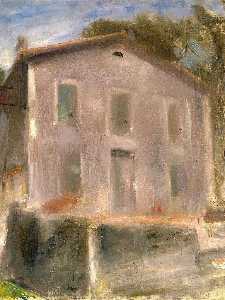Edwin Dickinson
Edwin Dickinson
Place: Seneca Falls
Born: 1891
Death: 1978
Biography:
Edwin Walter Dickinson was an American painter and draftsman best known for psychologically charged self-portraits, quickly painted landscapes, which he called premier coups, and large, hauntingly enigmatic paintings involving figures and objects painted from observation, in which he invested his greatest time and concern. His drawings are also widely admired and were the subject of the first book published on his work. Less well known are his premier coup portraits and nudes, his medium-sized paintings done entirely from imagination or incorporating elements from one of his drawings or done from observation over several days or weeks, including still lifes, portraits of others, both commissioned and not, and nudes.
Dickinson's art, always grounded in representation, has been compared to Surrealism, but the resemblance is superficial. His sensibility and emotional ties lie closer to Romanticism and Symbolism, and he was included in the Museum of Modern Art's 1943 exhibition Romantic Painting in America. But Dickinson generally avoided being grouped in any art movement, which contributed to his being somewhat marginalized, and he adamantly refused to take sides in the controversies between traditional representational painters and the avant-garde artists of the New York School, both groups of whom respected him. The tendency of his larger works toward monochrome, as well as the darkness of many of them, have also contributed to some observers' bewilderment and disapproval. Another complaint was that the strange juxtapositions and imagery in these works hint at underlying narratives or situations but their purpose is unclear, and Dickinson generally avoided explanation except to describe procedures, technical problems and formal concerns. Even when he mentioned the underlying subject or theme of a painting or identified figures or objects in it, he acted mystified about some of its particulars. But if some observers were frustrated and put off by the elusive character of the large paintings' content others have been moved by them and have attempted explanations to account for the power they experienced. The frequently voiced view among critics, museum directors, and artists that Dickinson deserved greater recognition, led one critic to call him "perhaps America's best-known, underknown artist."
Dickinson was born and raised in Seneca Falls, New York, in the Finger Lakes area; his family moved to Buffalo in 1897. The death of his mother from tuberculosis in 1903, the suicide in 1913 of his older brother, Burgess, his father's remarriage in 1914 to a much younger woman, and the death of a close friend in combat have all been cited as influences on the themes of his later work. As a boy Dickinson had assumed he would become a minister, like his father, but his brother's suggestion of a career in the navy proved more to his liking. Unfortunately, he failed the entrance exam of the U.S. Naval Academy twice. In 1911 he enrolled at the Art Students League, where he studied under William Merritt Chase. In the summers of 1912 and 1913 he stayed in Provincetown, Massachusetts, where he studied with Charles W. Hawthorne, and continued there year-round from 1913 to the summer of 1916, working as Hawthorne's assistant in 1914. From late summer 1916 through year's end Dickinson investigated the possibilities of printmaking in Provincetown with fellow painter Ross Moffett, and made further attempts in the '20s and '30s, but felt his time was better spent painting.
Hawthorne, who had himself been a student of Chase and perpetuated some of his ideas, had a strong influence on Dickinson's painting methods and ideas, many of which he retained in his later teaching. Dickinson's Self-Portrait of 1914 is what Hawthorne's students called a "mudhead," a back-lit figure built up in color patches, working outward from the center, rather than filling in contours. Hawthorne had his students use palette knives and even fingers, "as if painting had been just invented" and preventing them from trying to paint details instead establishing relationships between "spots" (i.e., patches) of color. From Hawthorne, Dickinson learned to look for the unexpected and to paint without formulas, to squint to determine value relationships, and to believe that a painting will be better if one leaves off when inspiration wanes, no matter how much is done. Dickinson's use of Hawthorne's ideas in his teaching has been described by one of his former students, Francis Cunningham.
Dickinson spent time teaching painting in Buffalo and working as a telegrapher in New York City until his naval service from late 1917 to 1919. War had interrupted Dickinson's plans to visit Europe with his close friend and fellow painter, Herbert Groesbeck, and while Dickinson served in the navy off the coast of New England Herbert traveled to Europe as a soldier and died in the Argonne Forest in one of the last battles of the war. His death seemed to reawaken Dickinson's pain over earlier losses of his mother and brother and to affect subsequent paintings. A trip to Paris to study art followed between December 1919 and July 1920, financed by a gift from Groesbeck's widow and parents of the insurance money paid on his death. Dickinson made a side trip to visit his grave in northern France and then to Spain; two paintings by El Greco in Toledo he declared the best he had ever seen, an admiration that persisted throughout his life. The subject of one was especially meaningful to Dickinson, having visited Groesbeck's grave so recently, The Burial of Count Orgaz.
More...
Wikipedia link: Click Here









